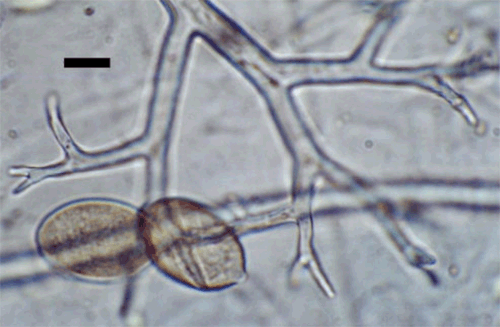Pseudoperonospora cubensis on Sechium edule in India
P. Baiswar A B , S. Chandra A and S. V. Ngachan AA ICAR Research Complex for NEH Region, Umiam-793103, Meghalaya, India.
B Corresponding author. Email: pbaiswar@yahoo.com
Australasian Plant Disease Notes 5(1) 3-4 https://doi.org/10.1071/DN10002
Submitted: 9 January 2009 Accepted: 7 December 2009 Published: 18 January 2010
Abstract
Sechium edule is commonly grown for its edible immature fruits, starchy roots, tender shoots and leaves by tribal populations in north-east India. Sechium edule is also grown in many South American and Asian countries. Downy mildew symptoms were observed on the leaves of S. edule. Based on the morphological characters the pathogen was identified as Pseudoperonospora cubensis. This is the first report of this organism causing downy mildew on S. edule in Meghalaya, India.
Sechium edule is grown in the hills of Meghalaya, Manipur, Mizoram, Nagaland, Sikkim and West Bengal in India (Rai et al. 2002). Edible immature fruits, tender shoots and large starchy roots of S. edule are eaten by tribal communities in north-east India. Roots are often used as a substitute for potato (Yadav et al. 2005). Sechium edule is also grown in Mexico, Brazil, Taiwan, China and Cuba. Fruits are used for preparing pasta, sauces and juice. Medicinal uses, including leaf infusions forz dissolving kidney stones, and for treatment of arteriosclerosis and hypertension, have also been documented (Saade 1994).
Downy mildew symptoms were observed on the leaves of S. edule during September 2008 in Barapani, Meghalaya (north-east India). Symptoms included yellow spots on the upper leaf surface. Heavy sporulation was observed on the lower surface of the leaves. Later on leaves turned necrotic. Voucher specimens have been deposited in Herbarium Cryptogamme India Orientalis, New Delhi, India (HCIO No. 48787) and in Institute Herbarium of ICAR Research Complex for NEH Region, Meghalaya, India (ICARHNEH-56).
Fungal structures were harvested by dislodging them from infected tissue onto a strip of clear tape (Correll et al. 1987). Sporangiophores emerging from stomata were of 184–(220)–288 × 5–(6.4)–8 μm (n = 50). Overall branching pattern of sporangiophores was monopodial. Ultimate branchlets measured 5–(7)–12 × 1–(1.9)–3 μm (n = 50). Brown sporangia (25–(28.1)–33 × 18–(18.8)–20 μm) were ovoid to ellipsoidal in shape with l/b ratio 1.3–(1.6)–1.7 (n = 50). Prominent hyaline papilla were also present on sporangia. The sporangia were narrowing toward the apical and distal ends (Fig. 1). Haustoria appeared to be clavate-branched. Based on these observations the organism was identified as Pseudoperonospora cubensis (Choi et al. 2005; Ko et al. 2008; Voglmayr et al. 2008). Monophyly of the genus Pseudoperonospora has also been confirmed through extensive molecular analysis (Riethmüller et al. 2002). Pathogenicity was confirmed by spraying a sporangial suspension on healthy twigs of S. edule; non-inoculated twigs served as control. Inoculated leaves developed symptoms after 12–16 days whereas control plants remained healthy.

|
This pathogen has been reported on S. edule from Brazil, Cuba, Panama, China and Taiwan (Farr et al. 2005; Ko et al. 2008). Many species have been reported to be the host of P. cubensis viz. species of the genera Benincasa, Lagenaria, Luffa, Momordica, Trichosanthes, Cucumis, Cucurbita and Citrullus (Crous et al. 2004). To our knowledge, this is the first report of P. cubensis on S. edule from India. Downy mildew is of concern to tribal populations of north-east India since this crop is grown extensively for human and animal consumption.
Choi YJ,
Hong SB, Shin HD
(2005) A reconsideration of Pseudoperonospora cubensis and P. humuli based on molecular and morphological data. Mycological Research 109, 841–848.
| Crossref | GoogleScholarGoogle Scholar |
CAS |
PubMed |

Correll JC,
Gordon TR, Elliott VJ
(1987) Host range, specificity and biometrical measurements of Leveillula taurica in California. Plant Disease 71, 248–251.
| Crossref | GoogleScholarGoogle Scholar |

Ko Y,
Chen CY,
Liu CW,
Chen SS,
Maruthasalam S, Lin CH
(2008) First report of downy mildew caused by Pseudoperonospora cubensis on Chayote (Sechium edule) in Taiwan. Plant Disease 92, 1706.
| Crossref | GoogleScholarGoogle Scholar |

Rai N,
Yadav DS,
Nath A, Yadav RK
(2002) Chow-Chow – A poor man vegetable for northeastern hill region. Indian Farming 10, 18–19.

Riethmüller A,
Voglmayr H,
Göker M,
Weiß M, Oberwinkler F
(2002) Phylogenetic relationships of the downy mildews (Pernosporales) and related groups based on large subunit ribosomal DNA sequences. Mycologia 94, 834–849.
| Crossref | GoogleScholarGoogle Scholar |

Yadav RK,
Yadav DS, Sarma P
(2005) Diversity of cucurbitaceous crops in northeastern region. ENVIS Bulletin: Himalayan Ecology 13, 15–25.



